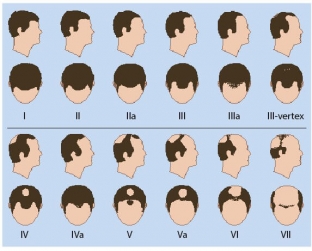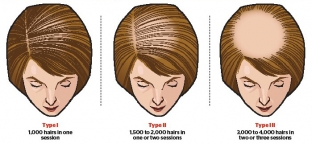Platelet-rich plasma (PRP) has long been used in orthopedics and other medical fields to promote wound healing and tissue repair in patients. In recent years, PRP therapy has also proven itself in clinical studies aimed at studying methods to combat baldness: platelet-rich plasma stimulates hair growth and increases their density. In this article, Dr. Ayda AlHammadi and Firas Al-Niaimi provide an overview of the current literature on the use of PRP for hair, in particular to combat androgenetic alopecia.
PRP for hair: preparation and administration of platelet-rich plasma
PRP – plasma obtained from the patient's autologous blood sample, with a high concentration of platelets – typically greater than 1 000 000 ppm. Upon activation, platelets release:
- blood clotting factors (such as fibrinogen, von Willebrand factor, factor V);
- chemokines (such as interleukin-8, beta-thromboglobulin, neutrophil-activating protein, platelet factor 4);
- adhesion molecules (such as P-selectin); and
- growth factors (such as platelet-derived growth factor, TRF-beta, vascular endothelial growth factor, stromal growth factor type 1 (CXCL 12), epidermal growth factor, fibroblast growth factor 7, b-catenin).
The clinical effects of PRP are based on the role of molecules released by platelets in the induction of inflammation, cell proliferation and differentiation, and angiogenesis.
The first step in PRP preparation is to collect venous blood from the patient (10-50 ml, depending on the device used). After that, an anticoagulant (for example, based on sodium citrate salts) is added to the blood. The required concentration of platelets in the blood is achieved by apheresis or centrifugation. At the same time, the latter method is used to obtain PRP much more often, since apheresis – a more expensive method with the risk of platelet damage.
In most cases, 2 centrifugation steps are required to obtain PRP:
- Blood is divided into three layers: lower – erythrocytes, average – leukocytes and platelets, upper – platelet-poor plasma (PPP).
- PPP enrichment with platelets.
Different PRP preparation systems use different centrifugation speeds and platelet activators (most commonly calcium chloride and calcium gluconate). Thus, the output is plasma with different concentrations of platelets, which explains the difference between the results of its use in clinical trials and in practice.
PRP for hair:
- Introduction of PRP for hair;
- problems in treatment of alopecia;
- mechanism of action of PRP for hair;
- PRP in the treatment of androgenetic alopecia.
Features of PRP injection for hair: tools and techniques
The release of growth factors begins 10 minutes after platelet activation, and within an hour after their activation, 95% of secretion is completed. Therefore, for optimal results, PRP is administered within 10 minutes of platelet activation.
Platelet-rich plasma is administered using various techniques (subcutaneous, intradermal injections, microneedling, interfollicular injections, nappage technique). Nappage technique involves the linear introduction of small volumes of PRP in the form of multiple injections, the distance between the injections is about 1 cm.
Injection of PRP for hair can be done with a 1 ml Luer lock syringe with a 27 or 30 gauge needle.
The procedure is generally safe, well tolerated by patients, and associated with only minor irritation. Serious allergic reactions resulting from the administration of PRP for hair have not been reported in the literature in the past 5 years.
PRP for hair and existing problems in the treatment of alopecia
Thick and healthy hair is a sign of attractiveness, youth, health and fertility in adults, therefore hair loss is often the cause of psychological discomfort and low self-esteem. Unfortunately, hair loss – a frequent complaint with which patients go to the doctor, fearing complete loss of hair.
In order to determine the cause of baldness, it is necessary to take a patient history, analyze the scalp and hair, as well as some laboratory tests.
Timely diagnosis and treatment can often help prevent the development of diseases that lead to complete hair loss.
Hair is constantly in one or another phase of the growth cycle: anagen, catagen, telogen, exogen. Each hair is completely independent of its neighbors, so different hairs can go through different phases of the growth cycle at the same time.

Fig. 2 Androgenetic male pattern baldness: Norwood scale
Accordingly, different types of alopecia are distinguished, which are associated with phases of the growth cycle (eg, telogen, anagen alopecia), or with inflammation that affects the hair follicle (eg, alopecia areata, scarring alopecia). Hair can be directly affected by pathologies that affect the hair follicles themselves, or indirectly by more extensive inflammatory processes that affect the entire scalp.
Intralesional steroid injections, systemic steroids, immunosuppressive drugs, antimalarials, or other drugs may be needed to treat inflammatory or autoimmune disorders. Delay in the treatment of inflammatory diseases can lead to permanent damage, therefore it is important to understand these basic concepts of hair pathologies in order to prevent the progression of irreversible hair loss.
Globally, the most common type of alopecia is androgenetic, affecting up to 40% of women and 80% of men, with approved treatment regimens for androgenetic alopecia (minoxidil, finastepide, or a combination of these drugs) being only partially effective.
The PRP hair treatment is safe, fast, well tolerated by patients.
In the era of regenerative medicine and the development of new hair therapies, PRP is seen as a promising treatment. Although the study of PRP therapy as a method of rejuvenation and hair regrowth is in its early stages, the results look promising.

Fig. 3 Androgenetic alopecia according to the female type: Ludwig scale
The PRP hair treatment is safe, fast, well tolerated by patients (eg compared to follicular transplantation). In fact, some studies have shown that pre-treatment of hair follicles with PRP has been shown to improve graft survival.
Mechanism of action of platelet-rich plasma (PRP) for hair
After activation, platelets are known to release many molecules, including growth factors, which play an important role in cell proliferation, regeneration and angiogenesis. The authors of various studies suggest that these growth factors can act on the stem cells of the hair follicles, thereby promoting the appearance of new bulbs and stimulating neovascularization.
There are two types of cells:
- stem cells of ectodermal origin, located in the zone of thickening of the hair follicles, from which epidermal cells and sebaceous glands are formed;
- germinal cells of mesenchymal origin that are found in the dermal papilla.
The interaction between these two populations of cells, in addition to the interaction between the various growth factors released from platelets, is thought to lead to the activation of the proliferation phase of the hair and hence promote the emergence of a new follicular unit.
Proliferation of dermal papillae is achieved through activation of fibroblast growth factor 7, beta-catechin, extracellular signal regulated kinase (ERK), and protein kinase B. Vascular endothelial growth factor promotes anagen-related angiogenesis, affects the growth of both healthy and pathological dermal structures. The hair follicle mesenchyme displays plasticity associated with the hair cycle, which plays a role in the transformation of the hair follicle (eg, from vellus to terminal and vice versa, as in androgenetic alopecia). Modulation of this process is important for improving the condition of the hair of patients with androgenetic alopecia. In addition, PRP increases blood flow to the hair follicles, and there is also an increase in the number of vascular structures around the hair follicles,
In general, growth factors released by activated platelets promote proliferation, differentiation and angiogenesis of hair follicles. In addition, they improve vascularization and blood flow to the hair follicles. PRP also prolongs the anagen phase and has anti-apoptotic properties.
PRP therapy has proven effective in the treatment of androgenetic alopecia in both female and male patterns.Thus, one study compared the efficacy of PRP injections and intralesional triamcinolone (TrA) injections in 45 patients with androgenetic alopecia (3 treatments 1 month apart). The results of the study showed that the effectiveness of platelet-rich plasma exceeded that of TrA injections. See also:
- After 12 months: 60% of patients in the PRP group had a complete remission (only 27% in the TrA group);
- after 6 months: 0% of patients in the PRP group had a relapse of the disease (in the TrA group - 38%);
- After 12 months: 31% of patients in the PRP group had a relapse of the disease (in the TrA group - 71%).
Androgenetic alopecia is by far the most common type of baldness in the world. This disease is characterized by shortening of the anagen phase and transformation of terminal to vellus hair in patients with a genetic susceptibility.
Currently,
minoxidil and finasteride, as well as hair transplantation, are used to treat this condition.
- Minoxidil, which prolongs the anagen phase and enlarges the hair follicle by stimulating potassium channels and prostaglandin endoperoxide synthase 1, thereby increasing the level of prostaglandin E2. In addition, minoxidil promotes the survival of dermal papilla cells.
- Finasteride, which is a 5-alpha reductase inhibitor, blocks the conversion of testosterone to dihydrotestosterone, also prolongs the anagen phase and promotes hair growth and differentiation.
Minoxidil and finasteride can be used alone or in combination, and their therapeutic effect is only partial.
- Another solution to the problem of androgenetic alopecia is follicular hair transplantation, which is an invasive and costly treatment.
- an increase in the amount of hair;
- increase in hair thickness;
- increase hair density.
Combining Hair PRP with other therapies
Further research is needed to assess the effectiveness of combining hair PRP with other therapies, but the following applications are currently being considered:
- PRP + follicular hair transplant;
- PRP + herbal extracts;
- PRP + minoxidil/finasteride.
Good results (increased hair count and density) have been obtained at a relatively low cost and a high safety profile.Despite the existing evidence and clinical observations regarding the positive effects of PRP for hair rejuvenation, questions about the optimal amount, concentration, frequency and possible synergistic effects of combination therapy in hair rejuvenation remain open. Further research, as experts hope, will be able to shed light on some of these issues.
According to Prime magazine.







Add a comment